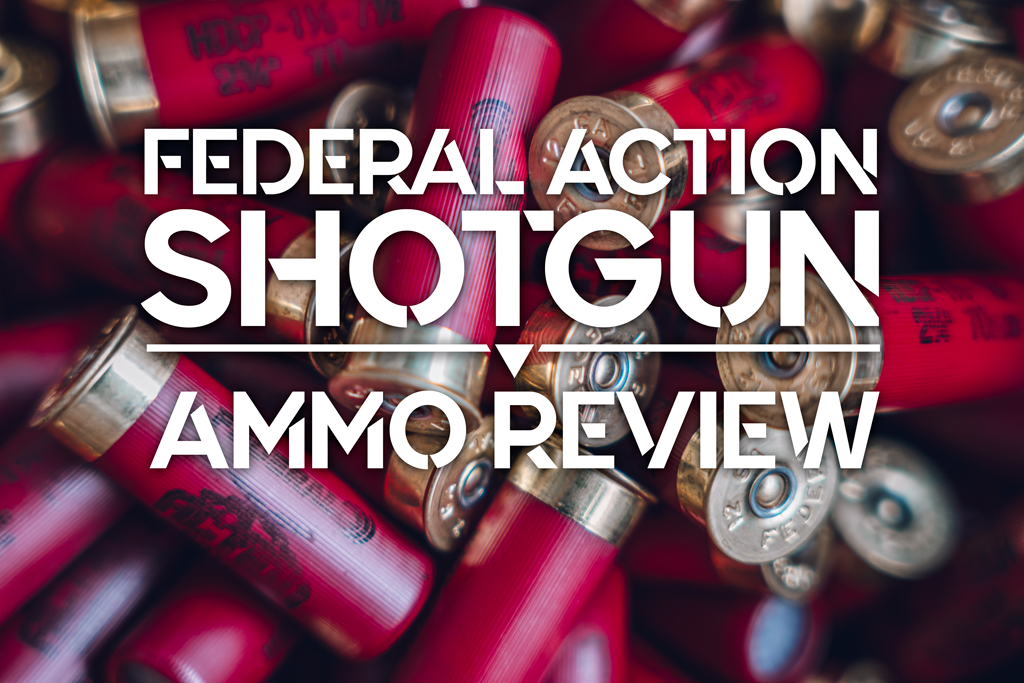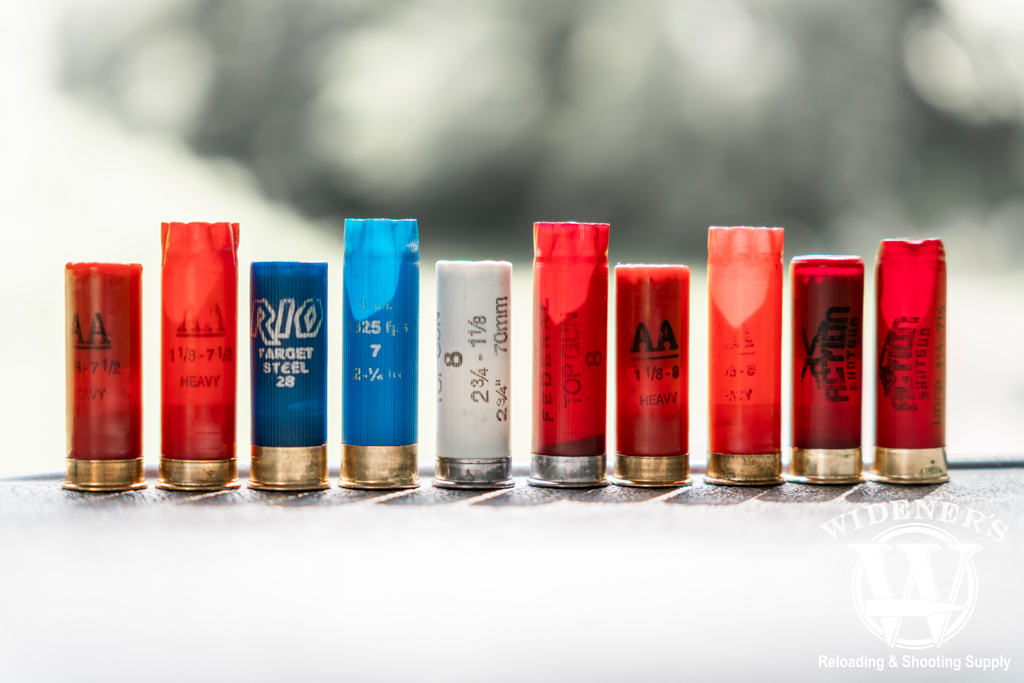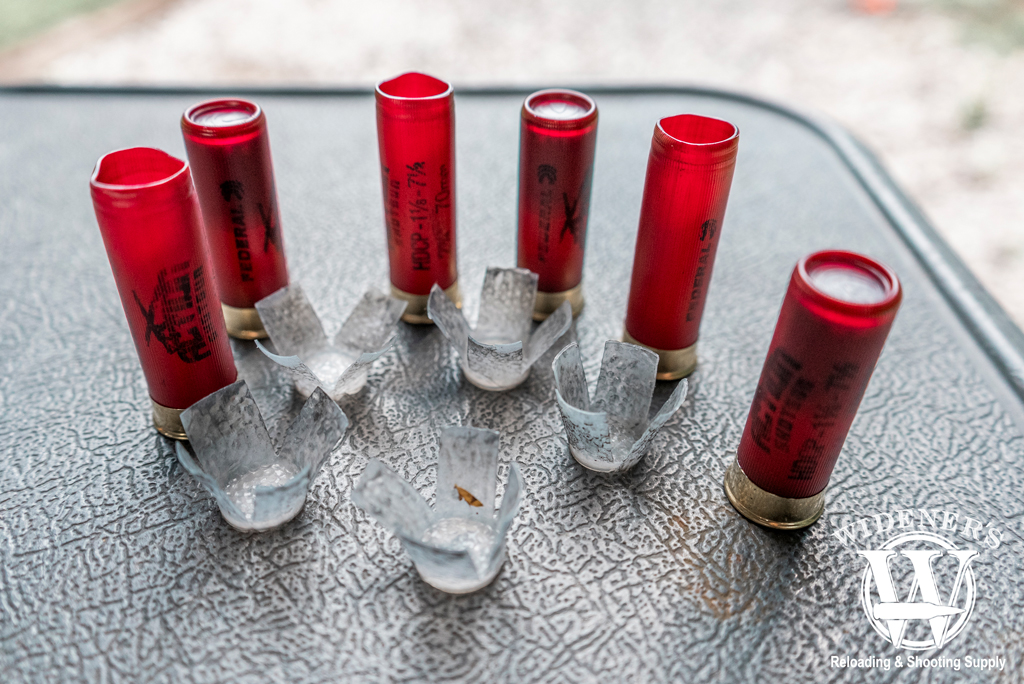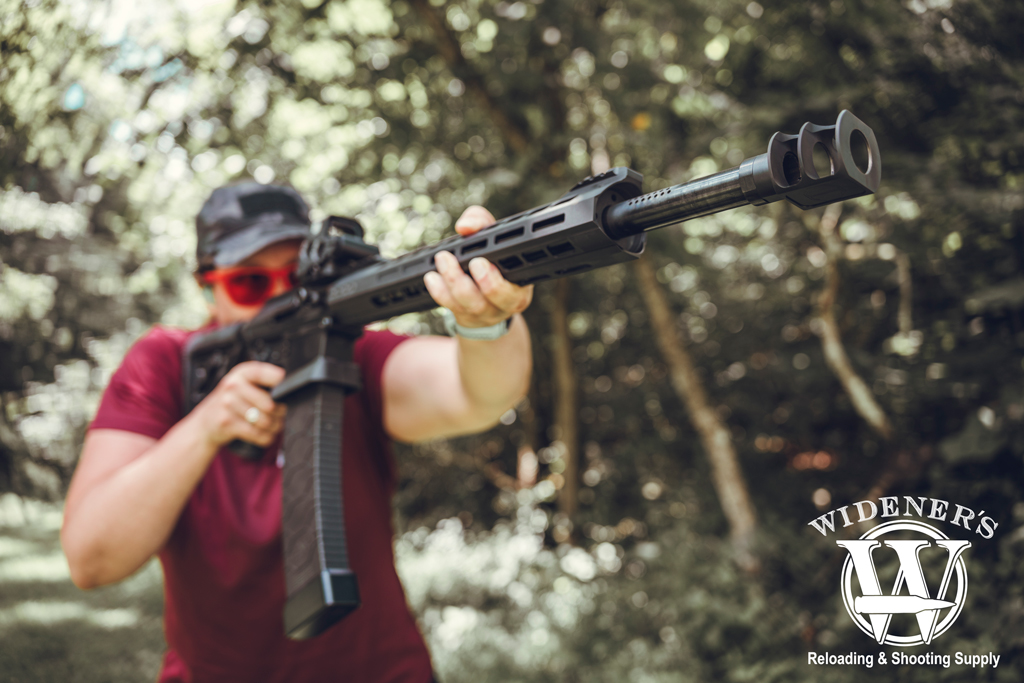Blog
Federal Action Shotgun Review

Guest Writer: Kenzie Fitzpatrick
Federal Premium has officially stepped up the shotgun game by introducing the Federal Action Shotgun 12 Gauge ammunition. They developed this ammunition for serious competition shooters needing shotgun shells that reliably feed and eject without malfunctions. The development of this shotshell didn’t happen overnight and required input from several high-level 3-gun competitive shooters. The result of what Federal released is a game-changer, especially for shotgunners running magazine-fed shotguns.
Those who don’t live and breathe 3-Gun or shoot Skeet, Trap, or Sporting Clays might not know how hard it is to find reliable shotgun ammunition. With so many shotshell manufacturers, shot sizes, payloads, and feet per second needs, it can be overwhelming to figure out what works for you and your shotgun.
Recently, the development and introduction of magazine-fed shotguns have posed issues with finding ammo that cycles nearly 100% in these firearms. Federal Action Shotgun ammunition has met many of these issues and concerns.
In this article, I will break down the problems with many shotshells on the market today and the solution to each problem that Federal Premium worked to fix.
Common Shotshell Problems

It’s easy to deform the case of standard shotgun shells, loading, ejecting, and temperatures, are the most common culprits.
Deformation of the Case
It doesn’t matter where in the country you live; the temperatures in the summertime can be rough on ammunition. High temperatures significantly affect shotshells because of the material of their hull. The hull holds the shotshell together. The head is made of brass or steel, along with the plastic or paper casing enclosing the rest of the shell.
Plastic material is malleable at higher temperatures. The deformation can occur more when stacking shells in a magazine instead of end-to-end, like most tube-fed shotguns. The plastic case can bulge and lose its shape, which will cause feeding issues.
Non-Rigid Wad
The components that make up a shotgun shell are critical. If you use cheaper, not-as-high-quality components, you’ll end up with cheaper, not-as-high-quality shells. A component crucial to the shotshell’s functionality is the wad.
The wad separates the powder from the actual shot and contains the shotgun shot. It creates the seal that prevents the gases from blowing through the shot and propels it out of the shotgun, along with the wad. Not all wads are the same, and having shotshells with looser wads or wads that come unsealed can cause significant issues when firing the shot.
Deformation of the Brass Head
Some shotgun shells use brass heads instead of steel heads. Unfortunately, brass is a very malleable metal and can also deform in higher temperatures. Deformation of these heads can cause ejection issues after the shot is fired. Ejection issues can include stovepipes, which consume a lot of time when you have to clear these malfunctions under the pressure of a timer.
Many people stress over whether or not ammunition will feed, but forget about the complications of what happens after firing a shot and how important it is to have proper ejection of spent shells or casings.
Folded Crimp Ejection Issues
At the end of shotgun shells is either a roll crimp or (most commonly) a folded crimp. If you’re familiar with slugs, most of these shotshells use a roll crimp with a shot card. Most birdshot ammunition uses a folded crimp, where the shell’s end folds over to prevent the shot from pouring out. The result is usually a pie-shaped pattern with multiple triangles closing up at the end of the shotshell. Shotgun ammunition manufacturers must leave about an extra quarter-inch after filling up the case to seal a shotshell with a folded crimp.
Once you fire a shot out of the shotgun, this folded crimp blooms to release the shot from the gun’s barrel. Then the entire shotshell case has to eject from the gun. In a tube shotgun or magazine-fed shotgun, the lengthened casing goes out the ejection port, where more issues can happen. That extra length from a folded crimp shotshell can cause stovepipes or cause the spent shell to stay stuck in the ejection port area.
Solutions to Common Shotshell Issues

The rigid hull and wad of Federal Action Shotgun ammo helps keep the shell from deforming.
Rigid Hull
The rigid hull design is the biggest improvement with the Federal Action Shotgun ammunition. The rigidity prevents the deformation of the shell, specifically when loading rounds on top of one another in a shotgun magazine. The structure of these shells also doesn’t deform as much in high temperatures as others tend to do.
Rigid Wad
Federal incorporated a rigid wad with the Federal Action Shotgun ammunition. Doing so all but eliminates any external or internal deformation issues with the hull or the wad.
Federal Action Shotgun: Roll Crimp
As mentioned, most birdshot shotshells feature a folded crimp at the end. This is typically the cheapest way to manufacture shotgun ammunition. The Federal Action Shotgun ammunition features a roll crimp at the end of the shotshell with a shot card covering the end. A shot card is a small disc or plate end cap that protects the shot and around which they crimp the shell. A little fancy detail of this shotshell is that Federal stamps its logo into the shot card.
The roll crimp offers a noteworthy benefit to the ejection process. That’s because the case of the shotshell only needs to be about ⅛ of an inch longer instead of ¼ of an inch to create the folded crimp. When you fire the shot, and the case tries to eject, there’s significantly less length to the spent casing than with a folded crimp shotshell. This shorter case is easier to extract and prevents malfunctions like stovepipes from occurring.
Plated Steel Head
Another detail Federal paid attention to is using a steel head instead of brass to aid the ejection process. As mentioned earlier, brass can deform, unlike its steel counterpart.
To give you all a little insight into what it takes to develop a new round, I sat down with Mike Whitesides and Lan Nguyen, Co-Owners of Dissident Arms, who helped develop the ammunition with Federal. Mike and Lan will represent the United States of America on the Men’s Open Team for Shotgun World Shoot this fall in Thailand. Their business is upgrading and improving shotguns, rifles, and pistol-caliber carbines to be competition-ready. Check out the full interview with them on our YouTube Channel.
Range Test: Federal Action Shotgun

From break action to pump-action, tube-fed, and mag-fed shotguns, Federal Action Shotgun runs in everything.
This ammunition is probably the most exciting ammo release for me in the last several years because I specifically shoot in Open Division in 3-Gun using a magazine-fed shotgun. Shotgun ammunition has been the most finicky ammo to run reliably, and the extreme heat temperatures that I shoot in significantly affect shotgun ammunition. Many 3-Gunners roll a cart around with a cooler to keep their shotshells in to prevent them from deforming. That’s ridiculous! So I headed out to the range with a Gen-12 magazine-fed shotgun from Genesis Arms, a semi-automatic TTI Benelli M2, and a Model 870 pump action shotgun to put this ammo to the test.
Case Gauge
If you don’t know what a case gauge is, it’s a tool that can check ammunition of all calibers for oversized or undersized cartridges. EGW makes my favorite case gauges, and the tool I used for testing the shotgun ammunition is their 6-round 12 gauge shotgun ammo checker.
The first test I performed on the range was leaving five different types of shotshells along with the Federal Action shotgun ammunition in the sun for 30 minutes before case gauging it. Two of the five shotshells failed to case gauge after being in the sun. There was no change to the Federal Action Shotgun ammunition, and it passed the case gauge test just fine.
You’d be surprised at how often factory ammunition fails to case gauge – in more than just shotgun ammunition. This has been a significant issue with shotgun shells for years. Factory ammunition would deform in shipping, after being in sunshine or hot temperatures, and even after feeding into the chamber and being ejected unfired. The rigidity of the hull is a true game changer for the reliability of this ammo and passing the first challenge of going through a case gauge.
Lan Nguyen, Co-Owner of Dissident Arms, shared his case gauging experience with me: “The correct components were chosen to make the rounds less likely to deform from temperature or pressure. This ammunition has not failed a case gauge in the 2500 pre-production rounds that we were sent to test.”
Gen-12 Magazine-Fed
The Gen-12 shotgun from Genesis Arms was brand new to me. It got put to the range test along with the Federal Action Shotgun Ammunition. I loaded up several magazines with the Action shotgun ammo. The fact that 150 rounds fed, ejected, and ran flawlessly through this shotgun floored me. I witnessed no malfunction or hiccup with the gun or the ammunition. To do a side-by-side comparison of ammo before and after firing, I shot some of the shotshells left in the sun that failed to case gauge. To the gun’s credit, it ate up all the ammunition just fine!
Benelli M2 Semi-Automatic
My TTI Benelli has yet to malfunction on me, and I hope I don’t jinx it now by writing that. While the Federal Action shotgun ammo is designed for stacking ammunition on top of one another without deforming, I was still curious to see how it ran in a tube-style shotgun. The test was boring with zero malfunctions, which didn’t surprise me with the gun or the ammunition.
870 Pump-Action
Pump-actions can be some of the most finicky shotguns when combined with inferior shotgun ammunition. This is because the shooter manipulates the gun’s action. If a shooter babies the gun and pumps the gun too slow, or doesn’t pull back hard enough, or whatever the scenario, this can cause failure to feed and eject issues. This is especially true with folded crimp shotgun ammunition because the spent shotshell has to clear the ejection port to eject. The pump-action also passed the range test with flying colors and had no hiccups running the Federal Action Shotgun Ammunition.
Federal Action Shotgun Specs
 100vw, 1024px” data-lazy-src=”https://blogmedia.wideners.com/blog/wp-content/uploads/DSC9757-Web.jpg”>
<p id=) With its innovative design and improvements, Federal Action Shotgun might be the ultimate target-shooting shell.
With its innovative design and improvements, Federal Action Shotgun might be the ultimate target-shooting shell.
| Caliber | Shell Length | Shell Type | Shot Type | Shot Size | Shot Charge | Muzzle Velocity | Muzzle Energy |
|---|---|---|---|---|---|---|---|
| 12-Gauge | 2-3/4″ | Target | BB | 7.5 | 1-1/8 OZ | 1,235 FPS | 1,600 FT LBS |
Muzzle Velocity: Does It Matter?
If you don’t have experience shooting a magazine-fed shotgun, they’re picky regarding what ammunition it cycles. Many Open shooters who run these types of shotguns choose to run 1250fps, some running 1300fps. They do this to guarantee it’ll cycle the round with no malfunctions.
Tube shotgunners usually run about 1200fps shotshells, but some can tune their shotguns to run the 1145fps light loads. The 1235 Federal Action shotgun ammunition is a sweet spot for magazine-fed and tube-style shotguns. It provides enough velocity for the shot to travel to the intended target. It also provides enough inertia or gas (depending on the shotgun) to properly cycle the bolt, eject the spent casing, and chamber a new one. It’s a very friendly middle ground to serve both markets well.
Downsides: Federal Action Shotgun
Yes, the Federal Action Shotgun 12 gauge ammunition isn’t cheap. Still, it’s the best quality ammunition (in my opinion) for magazine-fed shotguns. Serious competitive shooters know the value of not worrying about feeding or eject failures. They understand the peace of mind in trusting your gear, gun, and ammunition to flat-out work. When the top competitors are divided by seconds in time, one malfunction can cost you the win.
Gone are the days of lugging around coolers for your shotgun ammunition. This one shotshell is leaps and bounds beyond any other offering on the market today. During the testing phase of this ammo, competitive 3 Gun shooters, including Josh Froelich and others, used it. They’ve already won matches and divisions using this ammunition.
Reviews: Federal Action Shotgun
One of my friends, Dillen Easley, is a high-level competitive shooter. He was one of the early testers of the ammo before its release. He has zero affiliation with Federal, and here’s what he had to say about it:
“I ran a couple of full tubes through my Roth/Briley M2 and had zero issues, as expected. I then ran a very specific test in my Dissident Arms KL12. Using a fully loaded 20-round magazine, aggressively inserting the mag, chambering the top round, then extracting it, case gauging it, and putting it back into the mag … until I could no longer chamber the round.
I did this same test with a 1300fps Winchester AA and fully loaded magazine for comparison. The AA would no longer pass a case gauge after a handful or less, and the second round in the mag would not either (pressure from the 1st shell). After 8-9 shells … the AA would not chamber.”
Federal Action FTW
“The Action shotgun shell chambered exactly 100 times before I abandoned the test due to bruising on my arm and generally being worn out, and pictures were taken of when it would start standing proud in the case gauge, which was substantially later than the AAs.
After finishing that requested test, I shot to pattern with Diffusion, IC, Mod, and Full shotgun chokes. I put the IC choke back in and tested mini and full-sized poppers at distances, and they all fell or failed along the lines of the 1300fps AAs. I then shot the Action Shotgun shells for the remainder of the season in Open division without a single malfunction or hiccup. Multiple people noticed what I was shooting was different and even noticed a couple of folks pocketing hulls at matches to look at it more.
My conclusion? It’s a superior shotgun shell for all semi-auto use but especially for use in magazine-fed shotguns. I bought eight cases and have three more shipped for me to a match, which I bought, because I have no affiliation with Federal.”
Federal Action Shotgun: Final Thoughts

The bottom line: If you’re a serious competition shooter, don’t leave home without it!
Federal has made the ammunition more affordable than it would’ve been by shipping in 200-round cases instead of 25-round boxes, and the shotshells arrive in a bag inside the box. The bulk 200-round cases are perfect for competitive shooters, as we almost always buy in bulk, especially when we find a cartridge we can count on. You can get your own cases shipping now at Wideners.com.
I’m beyond excited to run this shotgun ammunition in 3 Gun competitions. As a fellow Open shooter shooting the Gen-12 shotgun, I will rely on this ammunition to run for me with zero malfunctions. That means the real test will be on me to perform!
